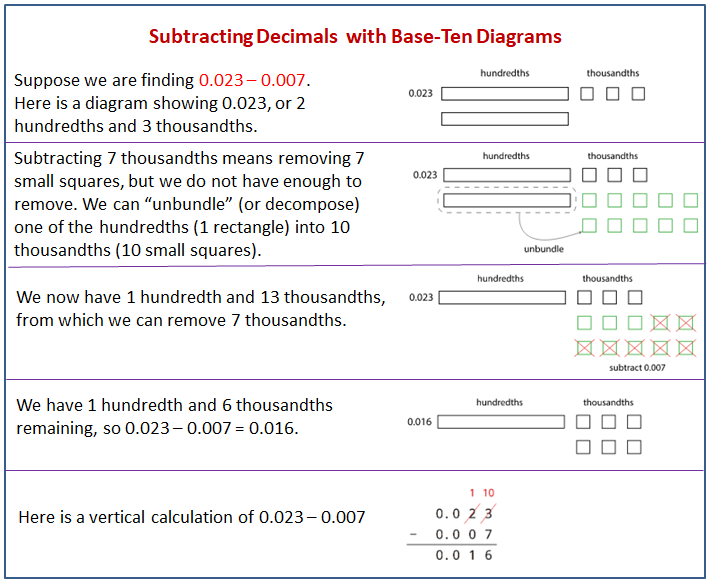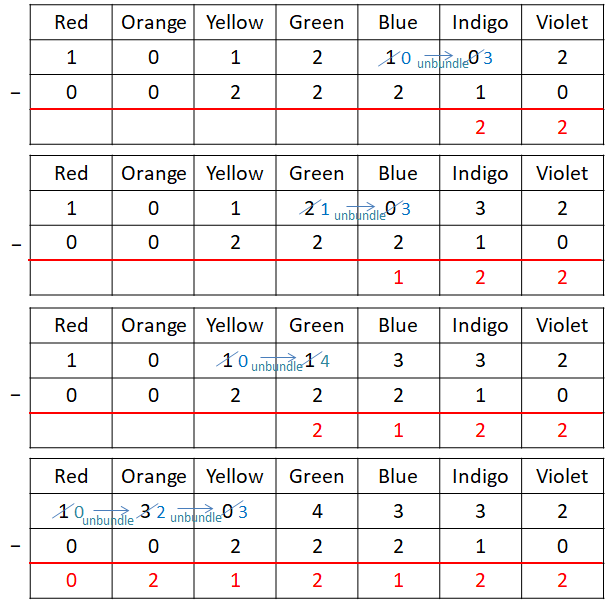Illustrative Mathematics Unit 6.5, Lesson 3: Adding and Subtracting Decimals with Few Non-Zero Digits
Learning Targets:
- I can tell whether writing or removing a zero in a decimal will change its value.
- I know how to solve subtraction problems with decimals that require “unbundling” or “decomposing.”
Related Pages
Illustrative Math
Grade 6
Lesson 3: Adding and Subtracting Decimals with Few Non-Zero Digits
Let’s add and subtract decimals.
Illustrative Math Unit 6.5, Lesson 3 (printable worksheets)
Lesson 3 Summary
The following diagram shows how to use base-ten diagrams to represent and reason about subtracting of decimals.

Lesson 3.1 Do the Zeros Matter?
- Evaluate mentally:
- Decide if each equation is true or false. Be prepared to explain your reasoning.
a. 34.56000 = 34.56
b. 25 = 25.0
c. 2.405 = 2.45
Scroll down the page for the solutions to the “Are you ready for more?” section.
Lesson 3.2 Calculating Sums
- Andre and Jada drew base-ten diagrams to represent 0.007 + 0.004. Andre drew 11 small rectangles. Jada drew only two figures: a square and a small rectangle.
a. If both students represented the sum correctly, what value does each small rectangle represent? What value does each square represent?
b. Draw or describe a diagram that could represent the sum 0.008 + 0.07. - Here are two calculations of 0.2 + 0.05. Which is correct? Explain why one is correct and the other is incorrect.
- Compute each sum. If you get stuck, draw base-ten diagrams to help you.
The applet has tools that create each of the base-ten blocks.
Select a Block tool, and then click on the screen to place it.
Show Applet
Lesson 3.3 Subtracting Decimals of Different Lengths
To represent , Diego and Noah drew different diagrams. Each rectangle shown here represents 0.1. Each square represents 0.01.
- Diego started by drawing 4 rectangles for 0.4. He then replaced 1 rectangle with 10 squares and crossed out 3 squares for the subtraction of 0.03, leaving 3 rectangles and 7 squares in his drawing.
- Noah started by drawing 4 rectangles for 0.4. He then crossed out 3 of them to represent the subtraction, leaving 1 rectangle in his drawing.
- Do you agree that either diagram correctly represents 0.4 - 0.03? Discuss your reasoning with a partner.
- To represent 0.4 - 0.03, Elena drew another diagram. She also started by drawing 4 rectangles. She then replaced all 4 rectangles with 40 squares and crossed out 3 squares for the subtraction of 0.03, leaving 37 squares in her drawing. Is her diagram correct? Discuss your reasoning with a partner.
- Find each difference. If you get stuck, you can use the applet to represent each expression and find its value.
a. 0.3 - 0.05
b. 2.1 - 0.4
c. 1.03- 0.06
d. 0.02 - 0.007
Be prepared to explain your reasoning.
- The applet has tools that create each of the base-ten blocks. This time you need to decide the value of each block before you begin.
- Select a Block tool, and then click on the screen to place it.
Show Applet
Are you ready for more?
A distant, magical land uses jewels for their bartering system. The jewels are valued and ranked in order of their rarity. Each jewel is worth 3 times the jewel immediately below it in the ranking. The ranking is red, orange, yellow, green, blue, indigo, and violet. So a red jewel is worth 3 orange jewels, a green jewel is worth 3 blue jewels, and so on.
At the Auld Shoppe, a shopper buys items that are worth 2 yellow jewels, 2 green jewels, 2 blue jewels, and 1 indigo jewel. If they came into the store with 1 red jewel, 1 yellow jewel, 2 green jewels, 1 blue jewel, and 2 violet jewels, what jewels do they leave with? Assume the shopkeeper gives them their change using as few jewels as possible.
Lesson 3 Practice Problems
- Here is a base-ten diagram that represents 1.13. Use the diagram to find 1.13 - 0.46.
Explain how you found the difference, or label your diagram to show your steps. - Compute the following sums. If you get stuck, you can draw base-ten diagrams.
a. 0.027 + 0.004
b. 0.203 + 0.1
c. 1.2 + 0.145 - A student said we cannot subtract 1.97 from 20 because 1.97 has two decimal digits and 20 has none. Do you agree with his statement? Explain or show your reasoning.
- Decide which calculation shows the correct way to find 0.3 - 0.006 and explain your reasoning.
- Complete the calculations so that each shows the correct difference.
- The school store sells pencils for $0.30 each, hats for $14.50 each, and binders for $3.20 each. Elena would like to buy 3 pencils, a hat, and 2 binders. She estimated that the cost will be less than $20.
a. Do you agree with her estimate? Explain your reasoning.
b. Estimate the number of pencils could she buy with $5. Explain or show your reasoning. - A rectangular prism measures 7½ cm by 12 cm by 15½ cm.
a. Calculate the number of cubes with edge length ½ cm that fit in this prism.
b. What is the volume of the prism in cm3? Show your reasoning. If you are stuck, think about how many cubes with ½-cm edge lengths fit into 1 cm3. - At a constant speed, a car travels 75 miles in 60 minutes. How far does the car travel in 18 minutes? If you get stuck, consider using the table.
| minutes | distance in miles |
| 60 | |
| 6 | |
| 18 |
The Open Up Resources math curriculum is free to download from the Open Up Resources website and is also available from Illustrative Mathematics.
Try out our new and fun Fraction Concoction Game.
Add and subtract fractions to make exciting fraction concoctions following a recipe. There are four levels of difficulty: Easy, medium, hard and insane. Practice the basics of fraction addition and subtraction or challenge yourself with the insane level.

We welcome your feedback, comments and questions about this site or page. Please submit your feedback or enquiries via our Feedback page.
